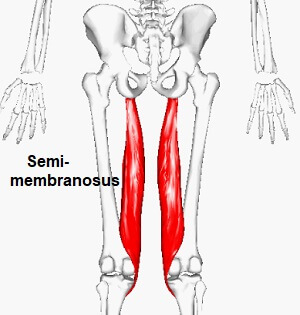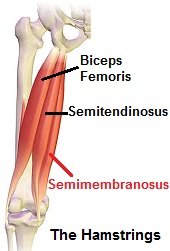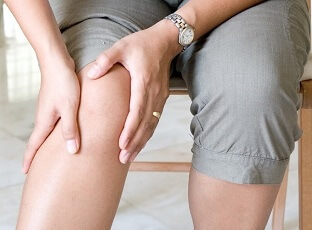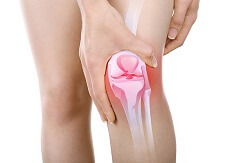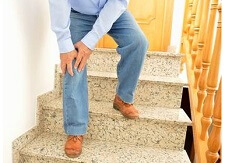- Home
- Knee Joint Anatomy
- Muscles
- Semimembranosus
Semimembranosus Muscle
Written By: Chloe Wilson, BSc(Hons) Physiotherapy
Reviewed by: KPE Medical Review Board
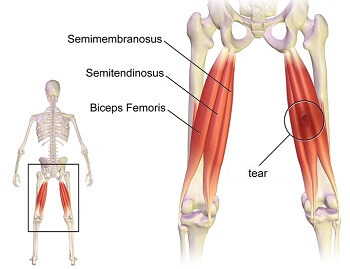
The semimembranosus muscle is the deepest and inner most of the hamstring muscles, found on the inner (medial) side of the back of the thigh.
It runs almost directly below one of the other hamstring muscles, semitendinosus.
The three hamstring muscles work together to bend the knee and play an important role in functional activities such as jumping, squatting and running.
Origin & Insertion
Semimembranosus originates from the upper lateral facet on the ischial tuberosity (part of the pelvis) attaching to it via a strong tendon.
Fleshy muscles fibers run downwards and slightly medially underneath semitendinosus and biceps femoris.
Just above the knee joint, semimembranosus narrows into an aponeurotic (flat and broad) tendon which attaches to a small, horizontal grove on the posteromedial surface of the medial tibial condyle.
Some fibers also blend with the medial collateral ligament, found on the inner side of the knee.
Other fibres pass upwards and laterally to form the oblique popliteal ligament which attaches to the posterolateral femoral condyle.
Semimembranosus is separated from the gastrocnemius calf muscle and the tibia via a bursa (small fluid filled sac) to reduce friction.
Function of Semimembranosus
The primary function of semimembranosus and the other two hamstring muscles is to bend the knee, e.g. when stepping over an object. They can also work to move the hip and when the trunk (back) is bent forwards e.g. when reaching down to pick something off the ground, the hamstrings work to extend the hip joint to help you come up to standing.
Another example with this is at the start of a sprint race where the hamstrings are particularly active in the initial push off and first 10-20m of acceleration. Here, the hamstrings work eccentrically, meaning they lengthen rather than contract), whilst being loaded, to produce speed, making them prone to injury.
When the knee is slightly bent (semi-flexed), the hamstrings can medially rotate the knee. The hamstring work together functionally with movements such as jumping, squatting, running and standing up from sitting. The also help to control knee movements such as slowing the speed at which your leg swings forwards when walking, working like brakes.
Common Problems
Common problems that affect semimembranosus include:
- Muscle Tightness: Tightness in the muscle can lead to excess friction and pressure on the semimembranosus bursa resulting in bursitis
- Muscle Weakness: Semimembranosus may have reduced strength or endurance
- Tendonitis: Overuse leads to nflammation or degeneration of the tendon causing hamstring tendonitis
- Muscle Tear: Over-stretching or overloading of the muscle can lead to a hamstring tear
If you are having problems with your semimembranosus muscle you might find the following articles helpful:
- Hamstring Stretches: Can't quite touch your toes? Then check out these simple yet effective hamstring stretches
- Hamstring Strengthening Exercises: People often have weak hamstrings compared to their quads which can lead to injury. Find out how to strengthen your hamstring muscles
- Common Knee Injuries: Learn more about the most common ways the knee gets injured
- Knee Muscles: If you want to learn more about the other hamstring muscles, or indeed any other knee muscles, this is the section for you
- Pain Behind The Knee: Find out about the other common causes of pain in the back of the knee, thigh and calf
Summary
- Muscle Group: Semimembranosus is the inner most (medial) hamstring muscle
- Action: Knee flexion and rotation, hip extension
- Origin: Ischial tuberosity
- Insertion: The back of the medial tibial condyle extending to the lateral tibial condyle via the oblique popliteal ligament
- Nerve Supply: Tibial division of the sciatic nerve (L5, S1, S2)
- Functional Activities: Coming up from bending forwards at the trunk, initial start of a sprint race
Other Knee Muscles
Page Last Updated: 05/07/23
Next Review Due: 05/07/25
